Granulometric Characterization of Wood Dust Emission from CNC Machining of Natural Wood and Medium Density Fiberboard
Abstract
1. Introduction
2. Materials and Methods
2.1. CNC Machine
2.2. Tool Parameters
2.3. Workpiece
2.4. Milling Parameters
3. Results and Discussion
4. Conclusions
Author Contributions
Funding
Acknowledgments
Conflicts of Interest
References
- Mohan, M.; Aprajita; Panwar, N.K. Effect of Wood Dust on Respiratory Health Status of Carpenters. J. Clin. Diagn. Res. 2013, 7, 1589–1591. [Google Scholar] [CrossRef] [PubMed]
- Hlásková, L.; Rogozinski, T.; Dolny, S.; Kopecký, Z.; Jedinák, M. Content of respirable and inhalable fractions in dust created while sawing beech wood and its modifications. Drewno 2015, 58, 135–146. [Google Scholar]
- Hancock, D.G.; Langley, M.E.; Chia, K.L.; Woodman, R.J.; Shanahan, E.M. Wood dust exposure and lung cancer risk: A meta-analysis. Occup. Environ. Med. 2015, 72, 889–898. [Google Scholar] [CrossRef]
- Rogozinski, T.; Wilkowski, J.; Gorski, J.; Szymanowski, K.; Podziewski, P.; Czarniak, P. Technical note: Fine Particles Content in Dust Created in CNC Milling of Selected Wood Composites. Wood Fiber Sci. 2017, 49, 461–469. [Google Scholar]
- Siew, S.S.; Martinsen, J.I.; Kjaerheim, K.; Sparén, P.; Tryggvadottir, L.; Weiderpass, E.; Pukkala, E. Occupational exposure to wood dust and risk of nasal and nasopharyngeal cancer: A case-control study among men in four nordic countries–With an emphasis on nasal adenocarcinoma. Int. J. Cancer 2017, 141, 2430–2436. [Google Scholar] [CrossRef] [PubMed]
- Mračková, E.; Krišťák, Ľ.; Kučerka, M.; Gaff, M.; Gajtanska, M. Creation of wood dust during wood processing: Size analysis, dust separation, and occupational health. BioResources 2016, 11, 209–222. [Google Scholar] [CrossRef]
- Matrat, M.; Radoi, L.; Févotte, J.; Guida, F.; Cénée, S.; Cyr, D.; Sanchez, M.; Menvielle, G.; Schmaus, A.; Marrer, E.; et al. Occupational exposure to wood dust and risk of lung cancer: The ICARE study. Occup. Environ. Med. 2019, 76, 901–907. [Google Scholar] [CrossRef]
- Molnar, Z.; Fuchs, I.; Tatai, S.; Magoss, E. Stability of planed and precision solid wood surfaces due to wetting. Maderas-Cienc. Tecnol. 2019, 21, 123–132. [Google Scholar] [CrossRef]
- Nasir, V.; Cool, J. A review on wood machining: Characterization, optimization, and monitoring of the sawing process. Wood Mater. Sci. Eng. 2020, 15, 1–16. [Google Scholar] [CrossRef]
- Pedzik, M.; Bednarz, J.; Kwidzinski, Z.; Rogozinski, T.; Smardzewski, J. The Idea of Mass Customization in the Door Industry Using the Example of the Company Porta KMI Poland. Sustainability 2020, 12, 3788. [Google Scholar] [CrossRef]
- Rogoziński, T.; Wilkowski, J.; Górski, J.; Czarniak, P.; Podziewski, P.; Szymanowski, K. Dust Creation in CNC Drilling of Wood Composites. Bioresources 2015, 10, 3657–3665. [Google Scholar] [CrossRef][Green Version]
- Piernik, M.; Rogozinski, T.; Krauss, A.; Pinkowski, G. The influence of the thermal modification of pine (Pinus sylvestris L.) wood on the creation of fine dust particles in plane milling: Fine dust creation in the plane milling of thermally modified pine wood. J. Occup. Health 2019, 61, 481–488. [Google Scholar] [CrossRef]
- Palmqvist, J.; Gustafsson, S.I. Emission of dust in planning and milling of wood. Holz Als Roh Und Werkst 1999, 57, 164–170. [Google Scholar] [CrossRef]
- Hlásková, L.; Rogozinski, T.; Kopecký, Z. Influence of Feed Speed on the Content of Fine Dust during Cutting of Two-Side-Laminated Particleboards. Drv. Ind. 2016, 67, 9–15. [Google Scholar] [CrossRef]
- Hazir, E.; Koc, K.H. Optimization of wood machining parameters in CNC routers: Taguchi orthogonal array based simulated angling algorithm. Maderas-Cienc. Tecnol. 2019, 21, 493–510. [Google Scholar] [CrossRef]
- Dünisch, O.; Bauch, J. Influence of Mineral Elements on Wood Formation of Old Growth Spruce (Picea abies [L.] Karst.). Holzforschung 1994, 48, 5–14. [Google Scholar] [CrossRef]
- Adler, A. Accumulation of Elements in Salix and Other Species Used in Vegetation Filters with Focus on Wood Fuel Quality. Doctoral Thesis, Swedish University of Agricultural Sciences, Uppsala, Sweden, 2007. [Google Scholar]
- Morakinyo, O.M.; Adebowale, A.S.; Mokgobu, M.I. Health risk of inhalation exposure to sub-10 µm particulate matter and gaseous pollutants in an urban-industrial area in South Africa: An ecological study. BMJ Open 2017, 7, e013941. [Google Scholar] [CrossRef] [PubMed]
- Nasir, V.; Cole, J. Characterization, optimization, and acoustic emission monitoring of airborne dust emission during wood sawing. Int. J. Adv. Manuf. Technol. 2020, 109, 2365–2375. [Google Scholar] [CrossRef]
- Health and Safety Executive. Medium Density Fiberboard (MDF) Hazard Assessment Document; Newsletter of the Wood-Working National Interest Group, National Agricultural Centre: Stoneleigh, UK, 2000. Available online: http://www.hse.gov.uk/woodworking/woodnig/woodn16.pdf (accessed on 7 May 2021).
- Burton, C.; Bradshaw, L.; Agius, R.; Burge, S.; Huggins, V.; Fishwick, D. Medium-density fibreboard and occupational asthma. A case series. Occup. Med. 2011, 61, 357–363. [Google Scholar] [CrossRef]
- Bell, H.K.; King, C.M. Allergic contact dermatitis from urea-formaldehyde resin in medium-density fibreboard (MDF). Contact Dermat. 2002, 46, 247. [Google Scholar] [CrossRef]
- Jacobsen, G.; Schaumburg, I.; Sigsgaard, T.; Schlünssen, V. Non-malignant respiratory diseases and occupational exposure to wood dust. Part I. Fresh wood and mixed wood industry. Ann. Agric. Environ. Med. 2010, 17, 15–28. [Google Scholar]
- Hejna, A.; Marc, M. Towards Understanding the Health Aspects of the Processing of Lignocellulosic Fillers. Proceedings 2020, 69, 34. [Google Scholar] [CrossRef]
- IARC. Wood dust. A review of human carcinogens: Arsenic, metals, fibres, and dusts. In IARC Monographs on the Evaluation of Carcinogenic Risks to Humans/World HEALTH Organization; International Agency for Research on Cancer: Lyon, France, 2012; Available online: https://www.iarc.who.int/ (accessed on 7 May 2021).
- Directive (EU) 2017/2398 of the European Parliament and of the Council of 12 December 2017 amending Directive 2004/37/EC on the Protection of Workers from the Risks Related to Exposure to Carcinogens or Mutagens at Work. Available online: http://data.europa.eu/eli/dir/2017/2398/oj (accessed on 8 May 2021).
- Scientific Committee on Occupational Exposure Limits (SCOEL). Recommendation from the Scientific Committee on Occupational Exposure Limits for Wood Dust; SCOEL/SUM/102B: Brussels, Belgium, 2002. [Google Scholar]
- Bhatti, P.; Newcomer, L.; Onstad, L.; Teschke, K.; Camp, J.; Morgan, M.; Vaughan, T.L. Wood dust exposure and risk of lung cancer. Occup. Environ. Med. 2011, 68, 599–604. [Google Scholar] [CrossRef]
- Pędzik, M.; Stuper-Szablewska, K.; Sydor, M.; Rogoziński, T. Influence of Grit Size and Wood Species on the Granularity of Dust Particles During Sanding. Appl. Sci. 2020, 10, 8165. [Google Scholar] [CrossRef]
- Pałubicki, B.; Hlásková, L.; Frömel-Frybort, S.; Rogozinski, T. Feed Force and Sawdust Geometry in Particleboard Sawing. Materials 2021, 14, 945. [Google Scholar] [CrossRef] [PubMed]
- Harrell, M.; Selvaraj, S.A.; Edgar, M. DANGER! Crisis Health Workers at Risk. Int. J. Environ. Res. Public Health 2020, 17, 5270. [Google Scholar] [CrossRef]
- Tudor, E.M.; Zwickl, C.; Eichinger, C.; Petutschnigg, A.; Barbu, M.C. Performance of softwood bark comminution technologies for determination of targeted particle size in further upcycling applications. J. Clean. Prod. 2020, 269, 122412. [Google Scholar] [CrossRef]
- Chung, K.; Cuthbert, R.; Revell, G.; Wassel, S.; Summers, N. A study on dust emission, particle size distribution and formal-dehyde concentration during machining of medium density fibreboard. Ann. Occup. Hyg. 2000, 44, 455–466. [Google Scholar] [CrossRef]
- Hejna, A.; Marć, M.; Skorczewska, K.; Szulc, J.; Korol, J.; Formela, K. Insights into modification of lignocellulosic fillers with isophorone diisocyanate: Structure, thermal stability and volatile organic compounds emission assessment. Eur. J. Wood Wood Prod. 2021, 79, 75–90. [Google Scholar] [CrossRef]
- Hejna, A.; Marc, M.; Korol, J. Modification of cellulosic filler with diisocynates—Volatile organic compounds emission assessment and stability of chemical structure over time. Nord. Pulp Pap. Res. J. 2021, 36, 353–372. [Google Scholar] [CrossRef]
- Taghiyari, H.R.; Esmailpour, A.; Papadopoulos, A.N. Paint Pull-Off Strength and Permeability in Nanosilver-Impregnated and Heat-Treated Beech Wood. Coatings 2019, 9, 723. [Google Scholar] [CrossRef]
- Papadopoulos, A.N.; Taghiyari, H.R. Innovative Wood Surface Treatments Based on Nanotechnology. Coatings 2019, 9, 866. [Google Scholar] [CrossRef]
- Taghiyari, H.R.; Bayani, S.; Militz, H.; Papadopoulos, A.N. Heat Treatment of Pine Wood: Possible Effect of Impregnation with Silver Nanosuspension. Forests 2020, 11, 466. [Google Scholar] [CrossRef]
- Kauppinen, T.; Vincent, R.; Liukkonen, T.; Grzebyk, M.; Kauppinen, A.; Welling, I.; Arezes, P.; Black, N.; Bochmann, F.; Campelo, F.; et al. Occupational Exposure to Inhalable Wood Dust in the Member States of the European Union. Ann. Occup. Hyg. 2006, 50, 549–561. [Google Scholar] [CrossRef] [PubMed]
- Dutkiewicz, J.; Cisak, E.; Sroka, J.; Wójcik-Fatla, A.; Zając, V. Biological agents as occupational hazards—Selected issues. Ann. Agric. Environ. Med. 2011, 18, 286–293. [Google Scholar]
- Sinn, G.; Chuchala, D.; Orlowski, K.A.; Taube, P. Cutting model parameters from frame sawing of natural and impregnated Scots pine (Pinus sylvestris L.). Eur. J. Wood Wood Prod. 2020, 78, 777–784. [Google Scholar] [CrossRef]
- Tureková, I.; Mračková, E.; Marková, I. Determination of Waste Industrial Dust Safety Characteristics. Int. J. Environ. Res. Public Health 2019, 16, 2103. [Google Scholar] [CrossRef] [PubMed]
- Vandličková, M.; Marková, I.; Makovická Osvaldová, L.; Gašpercová, S.; Svetlík, J.; Vraniak, J. Tropical Wood Dusts—Granulometry, Morfology and Ignition Temperature. Appl. Sci. 2020, 10, 7608. [Google Scholar] [CrossRef]
- Očkajová, A.; Kučerka, M.; Kminiak, R.; Krišťák, Ľ.; Igaz, R.; Réh, R. Occupational Exposure to Dust produced when Milling Thermally Modified Wood. Int. J. Environ. Res. Public Health 2020, 17, 1478. [Google Scholar] [CrossRef] [PubMed]
- Vandličkova, M.; Markova, I.; Holla, K.; Gašpercová, S. Evaluation of Marblewood Dust’s (Marmaroxylon racemosum) Effect on Ignition Risk. Appl. Sci. 2021, 11, 6874. [Google Scholar] [CrossRef]
- Andersen, A.; Barlow, L.; Engeland, A.; Kjaerheim, K.; Lynge, E.; Pukkala, E. Work-related cancer in the Nordic countries. Scand. J. Work. Environ. Health 1999, 25, 1–114. [Google Scholar] [PubMed]
- Yu, M.C.; Yuan, J.-M. Epidemiology of nasopharyngeal carcinoma. Semin. Cancer Biol. 2002, 12, 421–429. [Google Scholar] [CrossRef] [PubMed]
- Orlowski, K.; Chuchala, D.; Muzinski, T.; Baranski, J.; Banski, A.; Rogozinski, T. The effect of wood drying method on the granularity of sawdust obtained during the sawing process using the frame sawing machine. Acta Fac. Xylologiae Zvolen 2019, 61, 83–92. [Google Scholar]
- Hill, C.; Norton, A.; Dibdiaková, J. A comparison of the environmental impacts of different categories of insulation materials. Energy Build. 2018, 162, 12–20. [Google Scholar] [CrossRef]
- EN 324-1. Wood-Based Panels—Determination of Thickness, Width and Length; European Committee for Standardization: Brussels, Belgium, 1993. [Google Scholar]
- EN 324-2. Wood-Based Panels—Determination of Squareness and Edge Straightness; European Committee for Standardization: Brussels, Belgium, 1993. [Google Scholar]
- EN 322. Wood-Based Panels-Determination of Moisture Content; European Committee for Standardization: Brussels, Belgium, 1998. [Google Scholar]
- EN ISO 12460-5. Wood-Based Panels-Determination of Formaldehyde Release—Part 5. Extraction Method (Called the Perforator Method); European Committee for Standardization: Brussels, Belgium, 2015. [Google Scholar]
- EN 310. Wood-Based Panels-Determination of Modulus of Elasticity in Bending and of Bending Strength; European Committee for Standardization: Brussels, Belgium, 1999. [Google Scholar]
- EN 319. Particleboards and Fibreboards—Determination of Tensile Strength Perpendicular to the Plane of the Board; European Committee for Standardization: Brussels, Belgium, 1993. [Google Scholar]
- EN 317. Particleboards and Fibreboards–Determination of Swelling in Thickness after Immersion in Water; European Committee for Standardization: Brussels, Belgium, 1998. [Google Scholar]
- ISO 9096:2017. Air quality. Stationary Source emissions. Manual Determination of Mass concentration of Particulate Matter; International Organization for Standardization: Geneva, Switzerland, 2017. [Google Scholar]
- ISO 3310-1:2016. Test Sieves—Technical Requirements and Testing—Part 1: Test Sieves of Metal Wire Cloth; International Organization for Standardization: Geneva, Switzerland, 2016. [Google Scholar]
- Kminiak, R.; Banski, A. Granulometric analysis of chips from beech, oak and spruce woodturning blanks produced in the milling process using axial CNC machining center. Acta Fac. Xylologiae 2019, 61, 75–82. [Google Scholar]
- Svoreň, J.; Naščák, Ľ.; Koleda, P.; Barcík, Š.; Němec, M. The circular saw blade body modification by elastic material layer effecting circular saws sound pressure level when idling and cutting. Appl. Acoust. 2021, 179, 108028. [Google Scholar] [CrossRef]
- Atanasov, V.; Kovatchev, G. Determination of the cutting power during milling of wood-based materials. Acta Fac. Xylologiae 2019, 61, 93–101. [Google Scholar]
- Orlowski, K.A.; Dudek, P.; Chuchala, D.; Blacharski, W.; Przybylinski, T. The Design Development of the Sliding Table Saw Towards Improving its Dynamic Properties. Appl. Sci. 2020, 10, 7386. [Google Scholar] [CrossRef]
- Valcheva, L.; Savov, V. The Effect of Thickness of Medium Density Fiberboard Produced of Hardwood Tree Species on their Selected Physical and Mechanical Properties. Key Eng. Mater. 2016, 688, 115–121. [Google Scholar] [CrossRef]
- Kminiak, R.; Dzurenda, L. Impact of Sycamore Maple Thermal Treatment on a Granulometric Composition of Chips Obtained due to Processing on a CNC Machining Centre. Sustainability 2019, 11, 718. [Google Scholar] [CrossRef]
- Dzurenda, L.; Wasielewski, R.; Orlowski, K. Granulometric analysis of dry saw-dust from sawing process on the frame sawing Machine PRW-15M. Acta Fac. Xylologiae 2006, 48, 51–57. [Google Scholar]
- Igaz, R.; Kminiak, R.; Krišťák, L.; Němec, M.; Gergeľ, T. Methodology of Temperature Monitoring in the Process of CNC Machining of Solid Wood. Sustainability 2019, 11, 95. [Google Scholar] [CrossRef]
- Kopecký, Z.; Rousek, M. Dustiness in high-speed milling. Wood Res. 2007, 52, 65–76. [Google Scholar]
- Goli, G.; Fioravanti, M.; Marchal, R.; Uzielli, L. Up-milling and down-milling wood with different grain orientations—Theoretical background and general appearance of the chips. Eur. J. Wood Prod. 2009, 67, 257–263. [Google Scholar] [CrossRef]
- Taube, P.; Orlowski, K.A.; Chuchala, D.; Sandak, J. The Effect of Log Sorting Strategy on the Forecasted Lumber Value After Sawing Pine Wood. Acta Fac. Xylologiae 2020, 62, 89–102. [Google Scholar]
- Očkajová, A.; Kučerka, M.; Krišťák, Ľ.; Igaz, R. Granulometric Analysis of Sanding Dust from Selected Wood Species. Bioresources 2018, 13, 7481–7495. [Google Scholar] [CrossRef]
- Licow, R.; Chuchala, D.; Deja, M.; Orlowski, K.A.; Taube, P. Effect of Pine Impregnation and Feed Speed on Sound Level and Cutting Power in Wood Sawing. J. Clean. Prod. 2020, 272, 122833. [Google Scholar] [CrossRef]

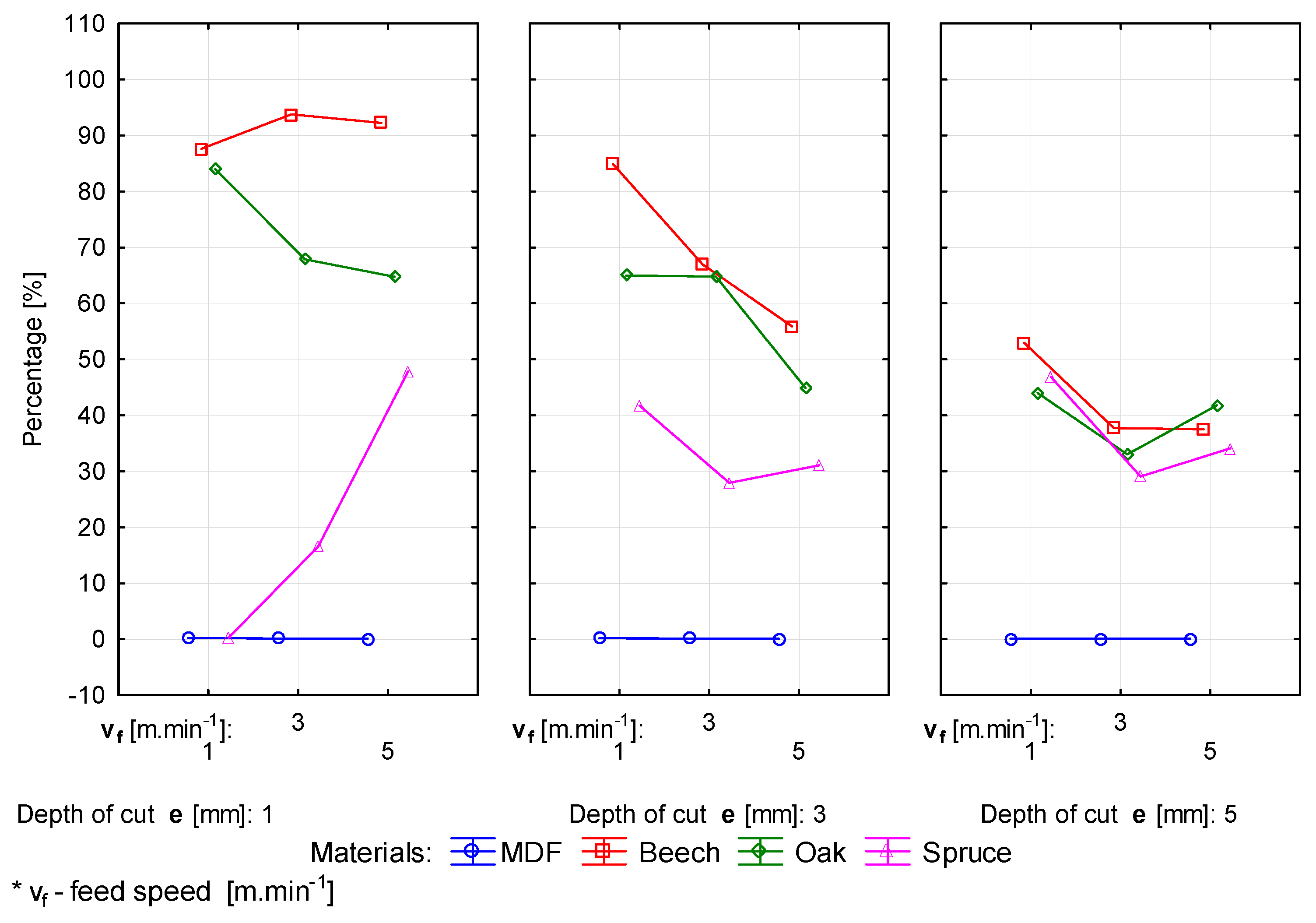
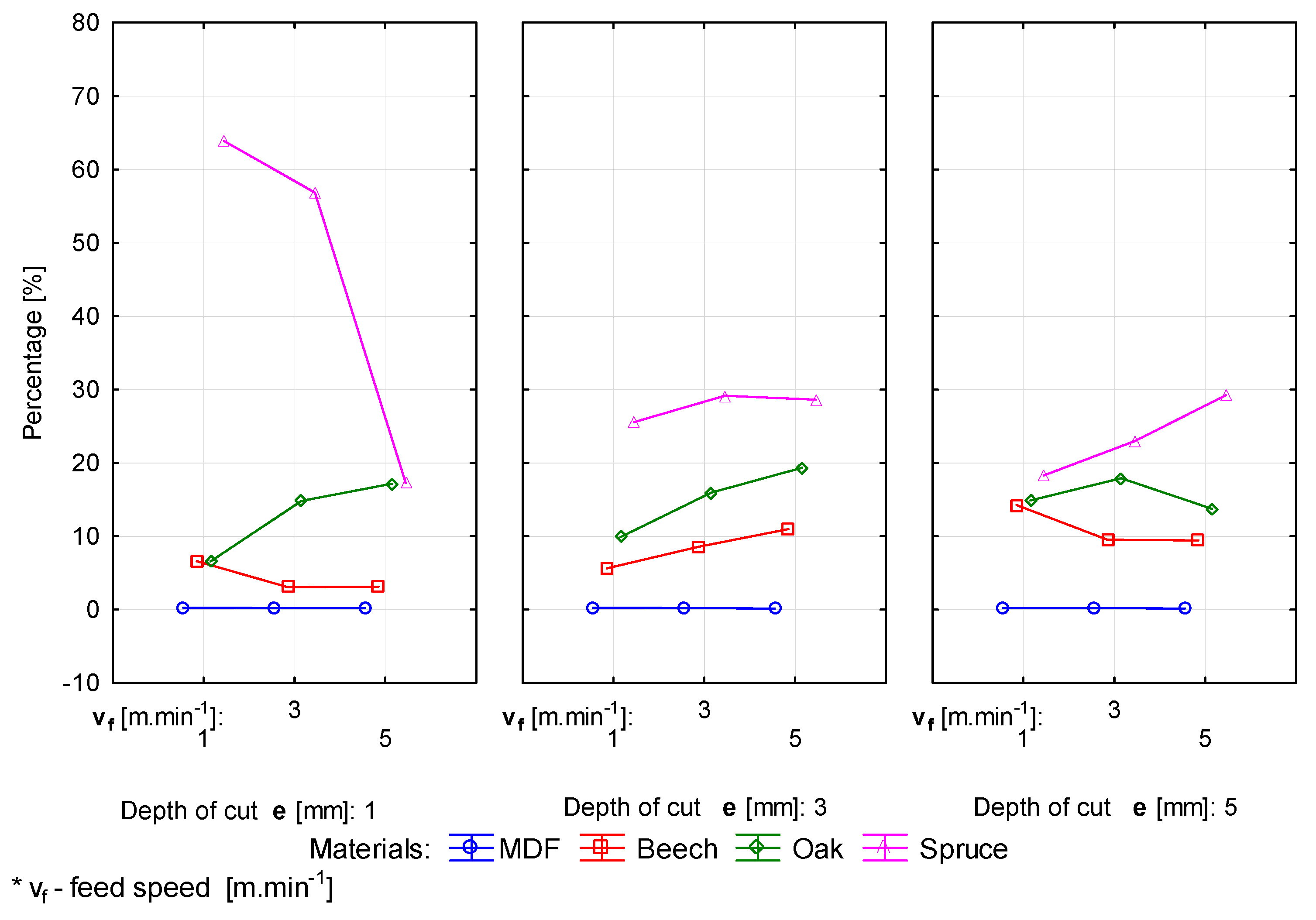

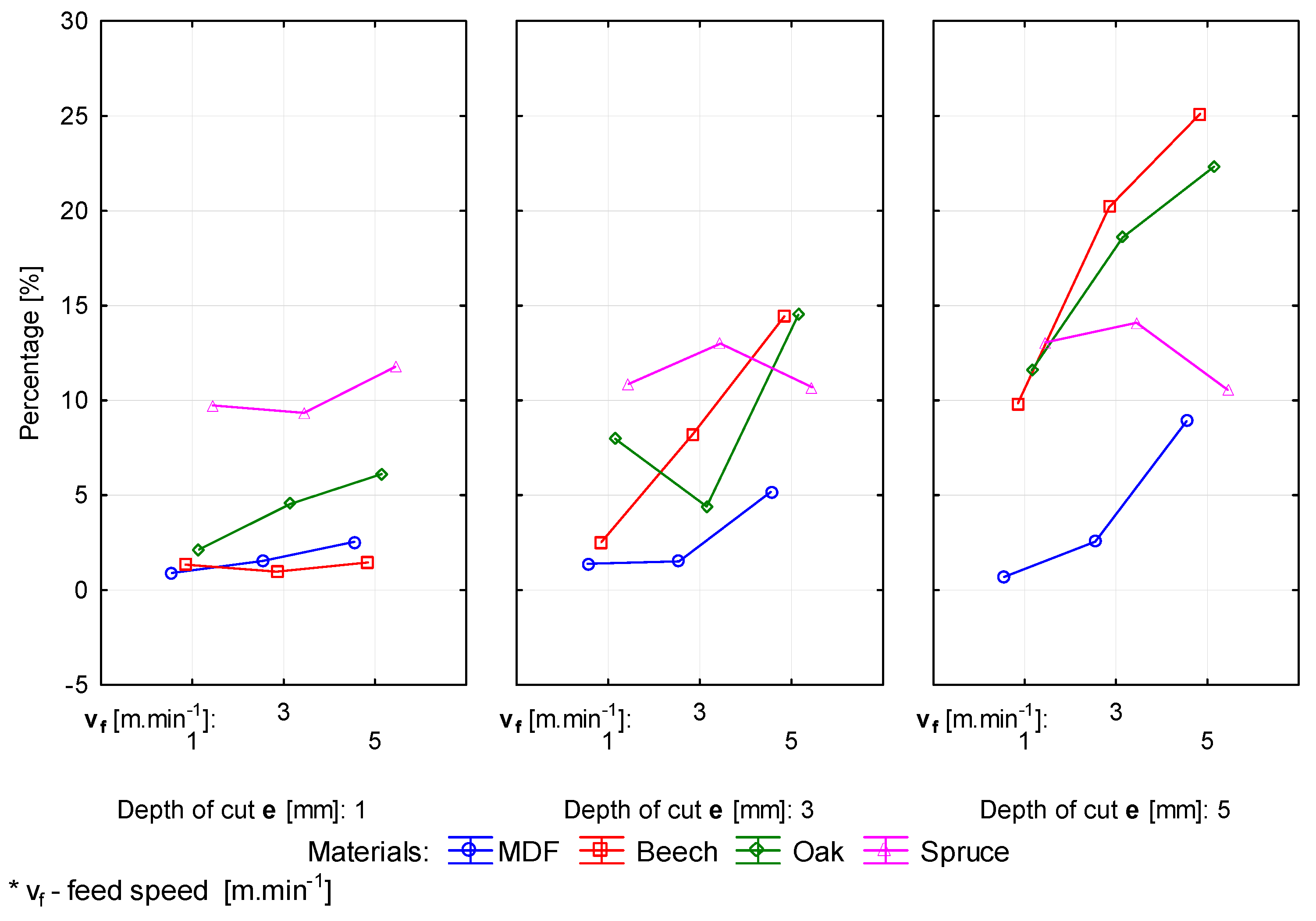
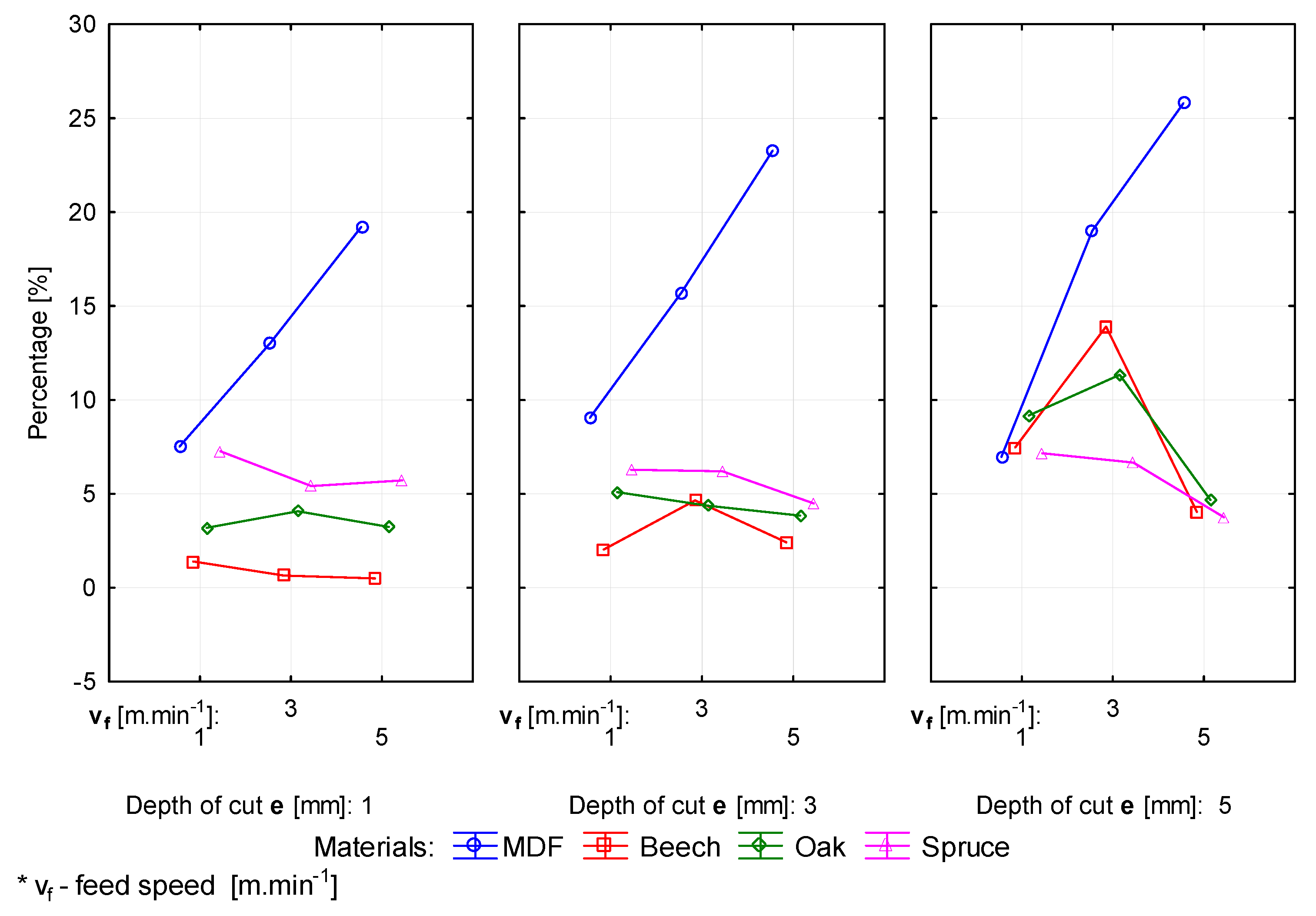

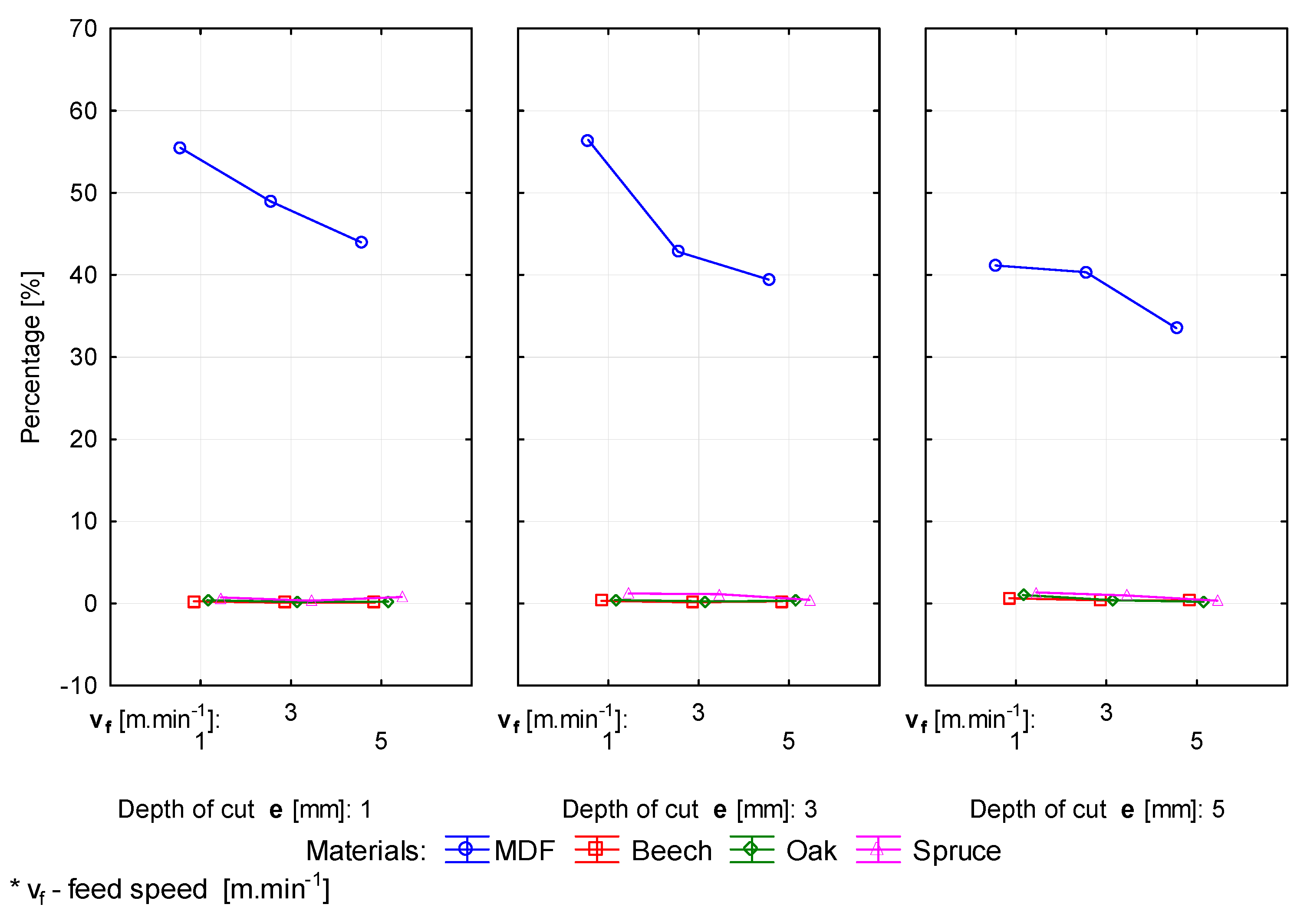
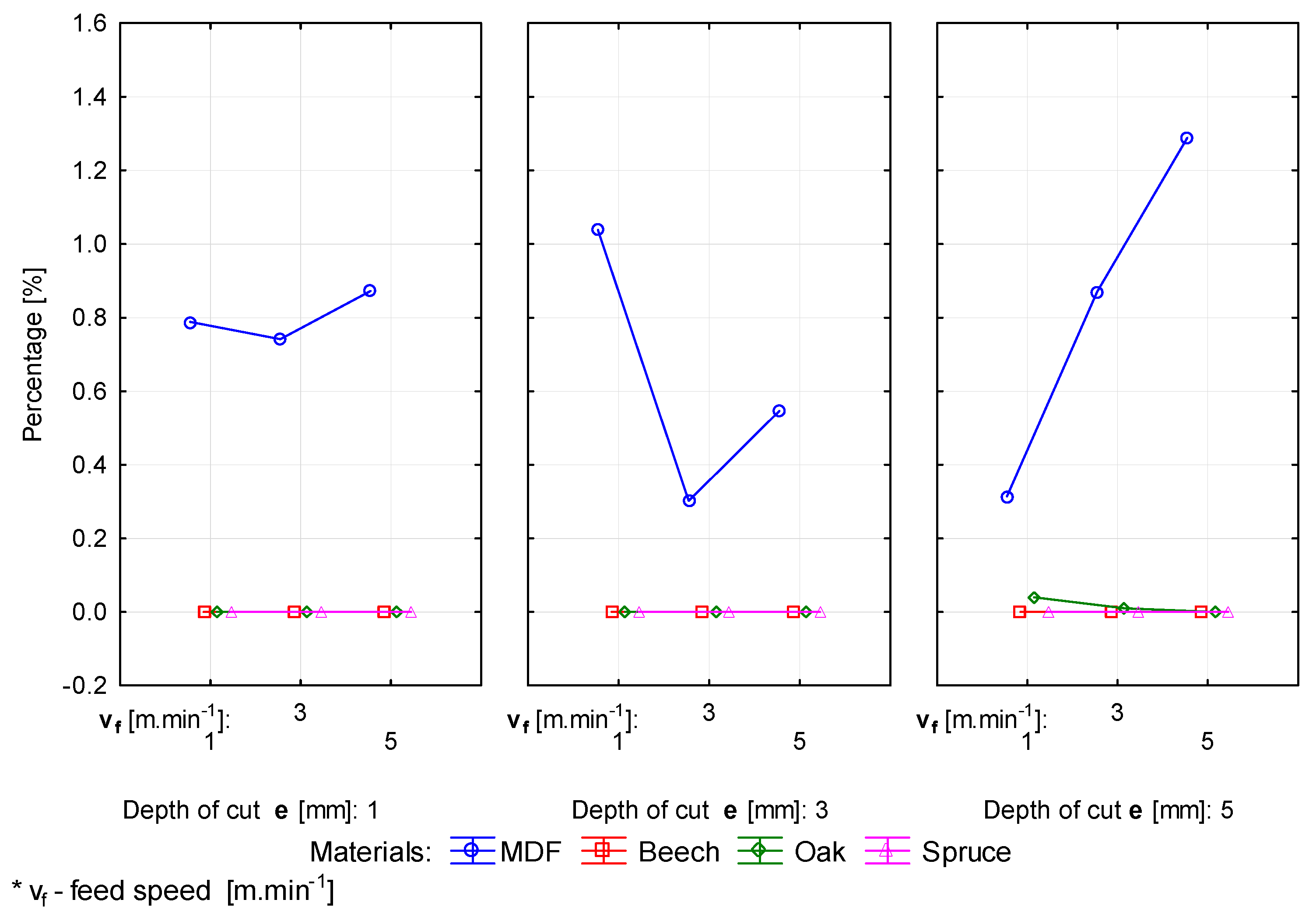
| Useful desktop | x = 3050 mm, y = 1300 mm, z = 300 mm |
| Speed X axis | 0 ÷ 70 m·min−1 |
| Speed Y axis | 0 ÷ 40 m·min−1 |
| Speed Z axis | 0 ÷ 15 m·min−1 |
| Vector rate | 0 ÷ 83 m·min−1 |
| Parameters of the Main Spindle Electric Spindle with HSK F63 Connection | |
| Rotation axis C | 640° |
| Rotation axis B | 320° |
| Revolutions | 600 ÷ 24,000 rpm |
| Power | 11 kW 24,000 rpm |
| 7.5 kW 10,000 rpm | |
| Maximum tool diameter | D = 160 mm |
| L = 180 mm | |
| Miller | Working Diameter D [mm] | Working Length l [mm] | Diameter of the Chucking Shank d [mm] | Dimensions of Used Blades L × W × T [mm] | Blade Material |
|---|---|---|---|---|---|
| KARNED 4451 | 16 | 49.5 | 12 | 49.5 × 9 × 1.5 | T10MG |
| Classes of TIGRA | ISO CODE | US CODE | Binder % | Hardness | Bending Strength | ||
|---|---|---|---|---|---|---|---|
| HV10 | HRA ± 0.2 | N/mm2 | Psi | ||||
| T10MG | K10-K40 | C3+ | 10 | 1650 | 92.3 | 3600 | 522,000 |
| Property | Test Method | Request |
|---|---|---|
| Thickness tolerance | EN 324-1 [50] | ±0.3 mm |
| Dimensions tolerance | EN 324-1 | ±5.0 mm |
| Squareness tolerance | EN 324-2 [51] | ±2 mm.m−1 |
| Humidity | EN 322 [52] | 4 ÷ 11% |
| Formaldehyde release | EN ISO 12460-5 [53] | <8 mg/100 g a. s. samples |
| Thickness range | 6–9; 9–12; 12–19; 19–30; 30–45 | |
| (mm) | ||
| Bending strength (modulus of rupture) | EN 310 [54] | 23; 22; 20; 18; 17 (MPa) |
| Tensile strength | EN 319 [55] | 0.65; 0.60; 0.55; 0.55; 0.50 (MPa) |
| Thickness swelling (24h) | EN 317 [56] | 17; 15; 12; 10; 8; (%) |
| Modulus of elasticity | EN 310 | 2800; 2500; 2200; 2150; 1900 (MPa) |
| Sieve Mesh [mm] | Fraction Type | Beech, Thickness 22 mm, Cutting Insert | ||||||||
| I. | II. | III. | IV. | V. | VI. | VII. | VIII. | IX. | ||
| vf1-e/1 | vf3-e/1 | vf5-e/1 | vf1-e/3 | vf3-e/3 | vf5-e/3 | vf1-e/5 | vf3-e/5 | vf5-e/5 | ||
| 2.000 | coarse | 94.2 | 96.86 | 95.36 | 90.58 | 75.5 | 66.85 | 67.22 | 47.24 | 46.94 |
| 1.000 | ||||||||||
| 0.500 | medium coarse | 3.09 | 2.03 | 3.68 | 5.95 | 19.09 | 29.49 | 21.27 | 36.69 | 47.38 |
| 0.250 | ||||||||||
| 0.125 | fine | 2.68 | 1.12 | 0.95 | 3.46 | 5.41 | 3.67 | 11.51 | 16.07 | 5.67 |
| 0.063 | ||||||||||
| 0.032 | ||||||||||
| <0.032 | ||||||||||
| Sieve mesh [mm] | Fraction type | Oak, thickness 22 mm, cutting insert | ||||||||
| I. | II. | III. | IV. | V. | VI. | VII. | VIII. | IX. | ||
| vf1-e/1 | vf3-e/1 | vf5-e/1 | vf1-e/3 | vf3-e/3 | vf5-e/3 | vf1-e/5 | vf3-e/5 | vf5-e/5 | ||
| 2.000 | coarse | 90.56 | 82.71 | 81.89 | 74.85 | 80.72 | 64.19 | 58.91 | 50.96 | 55.51 |
| 1.000 | ||||||||||
| 0.500 0.250 | medium coarse | 3.86 | 11.91 | 13.56 | 17.85 | 13.53 | 30.47 | 26.06 | 35.37 | 38.9 |
| 0.125 0.063 0.032 <0.032 | fine | 5.57 | 5.38 | 4.56 | 7.3 | 5.75 | 5.34 | 15.03 | 13.66 | 5.59 |
| Sieve mesh [mm] | Fraction type | Spruce, thickness 22 mm, cutting insert | ||||||||
| I. | II. | III. | IV. | V. | VI. | VII. | VIII. | IX. | ||
| vf1-e/1 | vf3-e/1 | vf5-e/1 | vf1-e/3 | vf3-e/3 | vf5-e/3 | vf1-e/5 | vf3-e/5 | vf5-e/5 | ||
| 2.000 | coarse | 64.12 | 73.4 | 65.1 | 67.3 | 57.1 | 59.69 | 65.16 | 52.04 | 63.33 |
| 1.000 | ||||||||||
| 0.500 0.250 | medium coarse | 24.48 | 18.39 | 25.34 | 21.16 | 32.23 | 33.23 | 22.17 | 37.54 | 31.2 |
| 0.125 0.063 0.032 <0.032 | fine | 11.39 | 8.22 | 9.56 | 11.54 | 10.68 | 7.09 | 12.67 | 10.42 | 5.47 |
| Sieve Mesh [mm] | Fraction type | MDF, thickness 22 mm, cutting insert | ||||||||
| I. | II. | III. | IV. | V. | VI. | VII. | VIII. | IX. | ||
| vf1-e/1 | vf3-e/1 | vf5-e/1 | vf1-e/3 | vf3-e/3 | vf5-e/3 | vf1-e/5 | vf3-e/5 | vf5-e/5 | ||
| 2.000 | coarse | 0.51 | 0.36 | 0.32 | 0.43 | 0.38 | 0.27 | 0.31 | 0.32 | 0.28 |
| 1.000 | ||||||||||
| 0.500 0.250 | medium coarse | 1.14 | 1.8 | 2.82 | 1.63 | 1.8 | 5.62 | 0.96 | 2.86 | 9.61 |
| 0.125 0.063 0.032 <0.032 | fine | 98.35 | 97.83 | 96.87 | 97.94 | 97.82 | 94.11 | 98.71 | 96.82 | 90.1 |
Publisher’s Note: MDPI stays neutral with regard to jurisdictional claims in published maps and institutional affiliations. |
© 2021 by the authors. Licensee MDPI, Basel, Switzerland. This article is an open access article distributed under the terms and conditions of the Creative Commons Attribution (CC BY) license (https://creativecommons.org/licenses/by/4.0/).
Share and Cite
Kminiak, R.; Kučerka, M.; Kristak, L.; Reh, R.; Antov, P.; Očkajová, A.; Rogoziński, T.; Pędzik, M. Granulometric Characterization of Wood Dust Emission from CNC Machining of Natural Wood and Medium Density Fiberboard. Forests 2021, 12, 1039. https://doi.org/10.3390/f12081039
Kminiak R, Kučerka M, Kristak L, Reh R, Antov P, Očkajová A, Rogoziński T, Pędzik M. Granulometric Characterization of Wood Dust Emission from CNC Machining of Natural Wood and Medium Density Fiberboard. Forests. 2021; 12(8):1039. https://doi.org/10.3390/f12081039
Chicago/Turabian StyleKminiak, Richard, Martin Kučerka, Lubos Kristak, Roman Reh, Petar Antov, Alena Očkajová, Tomasz Rogoziński, and Marta Pędzik. 2021. "Granulometric Characterization of Wood Dust Emission from CNC Machining of Natural Wood and Medium Density Fiberboard" Forests 12, no. 8: 1039. https://doi.org/10.3390/f12081039
APA StyleKminiak, R., Kučerka, M., Kristak, L., Reh, R., Antov, P., Očkajová, A., Rogoziński, T., & Pędzik, M. (2021). Granulometric Characterization of Wood Dust Emission from CNC Machining of Natural Wood and Medium Density Fiberboard. Forests, 12(8), 1039. https://doi.org/10.3390/f12081039













